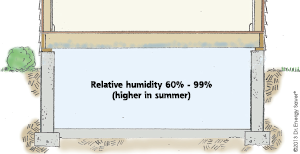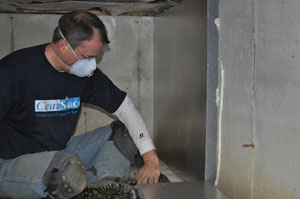Crawl Space Insulation
Typical insulation below done wrong
Improve the comfort level of your home and help prevent mold and moisture damage with the right crawl space insulation!
 Crawl spaces, especially those with dirt floors or moisture problems, are wet in summer and cold in winter! Crawl space wall and floor insulation can solve all that!
Crawl spaces, especially those with dirt floors or moisture problems, are wet in summer and cold in winter! Crawl space wall and floor insulation can solve all that!
Crawl space insulation is important. A number of comfort and energy problems can be caused by inadequate or incorrect crawl space insulation.
Signs of crawl space insulation problems:
-
The floor above the crawl space is unpleasantly cold in wintertime.
-
During cold weather, you have to keep the heat going nearly all the time to be comfortable in rooms directly above the crawl space.
-
Mice or other pests have taken up residence in fiberglass insulation installed between joists in the crawl space.
-
Fiberglass batt insulation has fallen out of place from between floor joists in the crawl space.
-
The crawl space smells moldy or has visible signs of mold.
-
The crawl space is damp all the time.
Crawl space insulation done wrong: fiberglass batts installed between joists as stated in the above Pic.
The old-fashioned way to insulate a crawl space was to install fiberglass batt insulation between joists in the crawl space, and to vent the crawl space so that outside air could circulate beneath the house.
Unfortunately, this combination usually leads to the problems listed above. Fiberglass insulation doesn’t respond well to the moist conditions that can be found in a crawl space.
The cotton-like material absorbs moisture, gets soggy, compresses and loses R-value. Fiberglass batts often end up on the crawl space floor in a soggy mess. The main advantage of fiberglass insulation –low cost—is totally negated when the material ceases to perform its main function.
Benefits of Rigid Foam Crawl Space Insulation
-
Stable and reliable. Unlike fiberglass insulation, rigid foam won’t compress, fall out of place or lose its R-value over time. It’s definitely a “once-and-done” improvement.
-
Effective air sealing. When joints between foam panels are taped, rigid foam stops air leaks that can waste energy. Fiberglass insulation can’t stop air movement.
-
Moisture-proof. Rigid foam won’t absorb moisture or be damaged by it.
-
Unfriendly to mold. Mold can’t take hold on rigid foam because it contains no organic food source and it doesn’t hold moisture.
-
Better ductwork performance. Ducts located in the crawl space benefit from rigid foam installed against crawl space walls.


 Looking good & lasting long. Rigid foam insulation can’t be damaged by moisture and won’t degrade in appearance or R-value over time. In a crawl space, it’s usually installed against the interior face of foundation walls.
Looking good & lasting long. Rigid foam insulation can’t be damaged by moisture and won’t degrade in appearance or R-value over time. In a crawl space, it’s usually installed against the interior face of foundation walls.